Ontario Provincial Police
Coordinates: 44°34′58″N 79°25′47″W / 44.5827949°N 79.4297702°W
| Ontario Provincial Police Police provinciale de l'Ontario | |
|---|---|
| Abbreviation | OPP |
|
Heraldic badge of the OPP | |
|
Shoulder flash of the OPP | |
|
OPP flag | |
| Motto | Safe Communities, A Secure Ontario |
| Agency overview | |
| Formed | October 13, 1909[1] |
| Employees | 7,383 |
| Volunteers | 853 Auxiliary Constables[2] |
| Annual budget | $1,003,014,800 (2012–13)[3] |
| Legal personality | Governmental: Government agency |
| Jurisdictional structure | |
| Operations jurisdiction* | Province of Ontario, Canada |
| Governing body | The Queen in Right of Ontario |
| Constituting instrument | Police Services Act of Ontario[4] |
| General nature | |
| Operational structure | |
| Headquarters | 777 Memorial Ave, Orillia, Ontario |
| Police Constables | 5,618[2] |
| Civilians | 1,765[2] |
| Elected officer responsible | Yasir Naqvi, Minister of Community Safety and Correctional Services |
| Agency executive | J.V.N. (Vince) Hawkes, Commissioner |
| Facilities | |
| Stations | 170[5] |
| Website | |
| www.opp.ca | |
| Footnotes | |
| * Divisional agency: Division of the country, over which the agency has usual operational jurisdiction. | |
The Ontario Provincial Police (OPP) is the Provincial Police service for the province of Ontario, Canada. In the late 1940s, policing functions were reorganized in Ontario, with the OPP given responsibility for all law enforcement in the Province outside areas covered by municipal police forces, together with overall authority for law enforcement on the King's Highways, enforcement of the provincial liquor laws, aiding the local police and maintaining a criminal investigation branch.[6]
The OPP is responsible for providing policing services over one million square kilometres of land and 174,000 km2 of water to a population of 2.3 million people (3.6 million in the summer months). As of 2010, the O.P.P. has over 6,200 uniformed, 850 auxiliary and 2,700 civilian personnel.[2] The vehicle fleet consists of 2,290 vehicles, 114 marine vessels, 286 snow and all-terrain vehicles, two helicopters and two fixed-wing aircraft. Rank Structure within the OPP is paramilitary or quasi-military in nature, with several "non-commissioned" ranks leading to the "officer" ranks. OPP officers are armed with SIG Sauer P229 compact-sized, service-type .40 caliber pistol, Remington 870 pump-action shotguns, the ARWEN 37 non-lethal 37 mm riot gun, the Taser X2, and the Close Quarter Battle combat rifle—variant of Colt Canada C8 rifle.
Overview
The OPP is the largest deployed police force in Ontario, and the second largest in Canada. The service is responsible for providing policing services throughout the province in areas lacking local police forces. It also provides specialized support to smaller municipal police forces, investigates province-wide and cross-jurisdictional crimes, patrols provincial highways, and is responsible for law enforcement on many of the waterways in the province. The OPP also works with other provincial agencies, including the Ministry of Transportation and Ministry of Natural Resources to enforce highway safety and conservation regulations, respectively. Finally, OPP officers provide security at the Ontario Legislature at Queen's Park in Toronto.
The OPP is one of three provincial police forces in Canada. The others are the Royal Newfoundland Constabulary in Newfoundland and Labrador and the Sûreté du Québec in Quebec.
History

At the First Parliament of Upper Canada on September 17, 1792, at Niagara-on-the-Lake, provision was made for the formation of a 'police system'. Initially, policing jurisdictions were limited to districts, townships, and parishes. In 1845, a Mounted Police Force was created, in order to keep the peace in areas surrounding the construction of public works.[7] It became the Ontario Mounted Police Force after Confederation.
In 1877, the Constables Act extended jurisdiction and gave designated police members authorization to act throughout the province.[8] The first salaried Provincial Constable appointed to act as Detective for the Government of Ontario was John Wilson Murray (1840–1906), hired on a temporary appointment in 1875 which was made permanent upon passage of the 1877 Act. Murray was joined by two additional detectives in 1897, marking the beginnings of the Criminal Investigation Branch. However, for the most part, policing outside of Ontario's cities was non-existent.
With the discovery of silver in Cobalt and gold in Timmins, lawlessness was increasingly becoming a problem in northern Ontario. Police constables were gradually introduced in various areas,[9] until an Order in Council decreed the establishment of a permanent organization of salaried constables designated as The Ontario Provincial Police Force on October 13, 1909.[10] It consisted of 45 men under the direction of Superintendent Joseph E. Rogers. The starting salary for constables was $400 per annum, increased to $900 in 1912. The first OPP detachment was located in Bala, Ontario.
In the 1920s, restructuring was undertaken with the passing of The Provincial Police Force Act, 1921.[11] The title of the commanding officer was changed to Commissioner and given responsibility for enforcing the provisions of The Ontario Temperance Act[12] and other liquor regulations. Major-General Harry Macintyre Cawthra-Elliot was appointed as the first Commissioner.
The OPP's first line of duty death occurred in 1923 when escaped convict Leo Rogers shot and killed Sergeant John Urquhart near North Bay. Rogers, who was later killed in a shootout with O.P.P. officers, had already mortally wounded North Bay City Constable Fred Lefebvre.
The first OPP motorcycle patrol was introduced in 1928, phased out in 1942 and then reintroduced in 1949. The first marked OPP patrol car was introduced in 1941.
During World War II, the Veterans Guard was formed. This was a body of volunteers (primarily World War I veterans), under the supervision of regular police members, protected vulnerable hydroelectric plants and the Welland Ship Canal.
In the late 1940s, policing functions were reorganized in Ontario, with the OPP given responsibility for all law enforcement in the Province outside areas covered by municipal police forces, together with overall authority for law enforcement on the King's Highways, enforcement of the provincial liquor laws, aiding the local police and maintaining a criminal investigation branch.[6]
Volunteers continue to serve with the OPP Auxiliary, which was originally formed in 1960 by an Order in Council when the program absorbed the Emergency Measures Organization who were trained in crowd control and first aid. It is recognized that OPP auxiliary constables shall not be utilized to replace regular members in any duties, but the Police Services Act does provide for instances when the Auxiliary Member may have the authority of a Police Officer.[13] This can occur in an emergency situation where the O.P.P. requires additional strength to cope with a special occasion or event.[14]
Women joined the uniform ranks in 1974.
In 1985, the OPP uniform was made more distinctive with the introduction of a blue trouser stripe to match a blue peak cap band.
In 1995, General Headquarters moved into its new facility in Orillia and for the first time in the history of the organization, all Bureaus were in one building.
During the 1990s, officer uniforms changed with darker shirts and matching body armour vests were introduced. In the early years the OPP wore olive green coloured uniforms.
From 1909 to 1930s, the OPP used stetsons as the official headgear and from 1997 to 2008. From 1930s to 1997 the peaked cap was worn and has been returned to service after 2008. During 1997 to 2008, the peaked cap was still worn by commanding officers of the force.
Organization and operations
The Ontario Provincial Police is responsible for providing policing services over one million square kilometres of land and 174,000 km2 of water to a population of 2.3 million people (3.6 million in the summer months). The OPP has over 6,100 uniformed, 850 auxiliary and 2,700 civilian personnel(2010).[2] The vehicle fleet consists of 2,290 vehicles, 114 marine vessels, 286 snow and all-terrain vehicles, two helicopters and two fixed-wing aircraft.
The province is divided into six operational regions:
- Central (headquartered in Orillia)
- East (headquartered in Smiths Falls)
- Highway Safety Division (HSD; headquartered in Aurora)
- North-East (headquartered in North Bay)
- North-West (headquartered in Thunder Bay)
- West (headquartered in London)
Field and operational services are provided from 163 police stations and satellite locations throughout Ontario. OPP stations are called "detachments".
The OPP General Headquarters are located in Orillia. Until 1995, the administration and headquarters divisions operated out of a number of buildings in Toronto. From 1973 to 1995 the headquarters were based out of the old Workmen's Compensation Board Building at 90 Harbour Street (now demolished). Operations were moved to Orillia as part of a government move to decentralize ministries and operations to other parts of Ontario. The first home in Orillia was Tudhope Building, formerly home to Tudhope Carriage and Motor Company (and part of the building housing Orillia City Hall).
In 1922, the OPP headquarters was on the second floor of the Legislature at Queen's Park in Toronto.[15]
Detachments
Current police stations ("Detachments") of the Ontario Provincial Police[16]
- Alexandria
- Almaguin Highlands
- Apsley
- Armstrong
- Arnprior
- Atikokan
- Bala
- Bancroft
- Barrie
- Bracebridge
- Brant County
- Bruce Peninsula
- Caledon
- Carleton Place
- Central Hastings
- Central Region Headquarters
- Chatham-Kent
- City of Kawartha Lakes
- City of Kawartha Lakes (Coboconk)
- Coldwater, Ontario
- Collingwood
- Dryden
- Dufferin
- Dutton
- Dorset, Ontario
- Ear Falls
- East Algoma (Blind River)
- East Algoma (Elliot Lake)
- East Algoma (Thessalon)
- East Region Headquarters
- Elgin County
- Elk Lake
- Emo
- Englehart
- Espanola
- Essex
- Essex County
- Exeter
- Foleyet
- Frontenac
- General Headquarters - OPP GHQ
- Gogama
- Gore Bay
- Gravenhurst
- Greenstone
- Grenville County (Kemptville)
- Grenville County (Prescott)
- Grey County
- Haldimand County
- Haliburton Highlands
- Hawkesbury
- Highway Safety Division Headquarters
- HSD-Aurora
- HSD-Auroa HSD Barrie
- HSD-Burlington
- HSD-Cambridge
- HSD-Hwy 407
- HSD-Milton
- HSD-Niagara
- HSD-Port Credit
- HSD-Toronto
- HSD-Toronto - East Collision Reporting Centre
- HSD-Toronto - North Collision Reporting Centre
- HSD-Toronto - West Collision Reporting Centre
- HSD-Whitby
- Huntsville
- Huron
- Huron - Goderich
- Huron Wingham
- Huron Exeter
- Huronia West
- Ignace
- Iroquois Falls
- James Bay (Cochrane)
- James Bay (Hearst)
- James Bay (Kapuskasing)
- James Bay (Moosonee)
- James Bay (Smooth Rock Falls)
- Kaladar
- Kapuskasing
- Kenora
- Killaloe
- Killarney
- Kingsville
- Kirkland Lake
- Lakeshore
- Lambton County
- Lambton (Corunna)
- Lambton (Forest)
- Lambton (Grand Bend)
- Lambton (Point Edward)
- Lanark County
- Lancaster
- Leamington
- Leeds County (Brockville)
- Little Current
- Loyalist
- Manitoulin (Manitowaning)
- Manitouwadge
- Marathon
- Markdale
- Matheson
- Mattawa
- Meaford
- Middlesex (Glencoe)
- Middlesex (London)
- Middlesex (Lucan)
- Middlesex (Strathroy)
- Minaki
- Mindemoya
- Morrisburg
- Napanee
- Nipigon
- Noelville
- Norfolk County
- North Bay
- North East Region Headquarters
- North Perth
- North West Region Headquarters
- Northumberland (Brighton)
- Northumberland (Campbellford)
- Northumberland (Cobourg)
- Nottawasaga
- Orillia
- Ottawa
- Oxford
- Pelee Island (summer)
- Pembroke
- Perth County
- Peterborough County
- Pickle Lake
- Powassan
- Prince Edward
- Quinte West
- Rainy River
- Rainy River District
- Rama First Nation (Mnjikaning)
- Red Lake
- Renfrew
- Rideau Lakes
- Russell County
- Russell County (Rockland)
- Sauble Beach (summer)
- Sault Ste. Marie
- Schreiber
- Shabaqua Corners
- Sharbot Lake
- Sioux Lookout
- Sioux Narrows-Nestor Falls
- South Bruce
- South Porcupine
- Southern Georgian Bay
- Springwater
- Stormont, Dundas and Glengarry
- Sudbury
- Superior East (Chapleau)
- Superior East (Hornepayne)
- Superior East (Wawa)
- Superior East (White River)
- Tecumseh
- Temagami
- Temiskaming
- Thousand Islands
- Thunder Bay
- Tobermory (summer)
- Town of the Blue Mountains
- Upper Ottawa Valley
- Upsala
- Walkerton
- Warren
- Wellington County (Fergus)
- Wellington County (Mount Forest)
- Wellington County (Palmerston)
- Wellington County (Palmerston)
- Wellington County (Rockwood)
- West Parry Sound
- West Parry Sound (Still River)
- Western Region Headquarters
- Whitney
- Winchester
Legislative Security Service
The Legislative Security Service consists of Special Constables who provide security services to the Legislative Precinct (Legislature Building and Whitney Block) and report to the Sergeant-at-Arms.[17]
Training
All recruits attend the Ontario Police College in Aylmer, Ontario and complete their training at OPP facilities in Orillia. Historically, new recruits were trained in a variety of facilities in and around Toronto until the OPP Training and Development Centre was opened in Brampton in 1981. It remained in operation until 1998, when training moved to the Orillia headquarters.
Rank
Rank Structure within the OPP is paramilitary or quasi-military in nature, with several "non-commissioned" ranks leading to the "officer" ranks. Contrary to popular belief, the Detective ranks fall laterally with the uniform ranks and is not a promotion above.
| RANK | Commissioner | Deputy Commissioner (Provincial Commander) | Chief Superintendent | Superintendent | Inspector | Staff Sergeant / Detective Staff Sergeant / Traffic Staff Sergeant | Sergeant / Detective Sergeant / Traffic Sergeant | Constable / Detective Constable |
|---|---|---|---|---|---|---|---|---|
| INSIGNIA
(Slip-on) |
 |
 |
 |
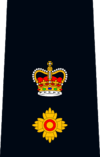 |
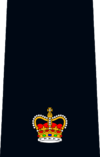 |
 |
 |
No Insignia |
| INSIGNIA
(Shoulder Board) |
.png) |
.png) |
.png) |
.png) |
.png) |
Shoulder Boards not used for these ranks | ||
| OTHER INSIGNIA | ||||
|---|---|---|---|---|
| TITLE | Senior Security Officer | Security Officer | Special Constable | Auxiliary |
| INSIGNIA | 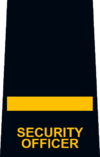 |
 |
 |
 |
| NOTES | General Headquarters Security and Queens Park Security | Electronic Crime Section, Forensic Investigators, Court Security, and Offender Transport Officers | See "Auxiliary Policing Program" section | |
Auxiliary Policing Program
About the Auxiliary
Auxiliary members have no police authority. They must rely on the same arrest provisions as regular citizens. There are some instances when an Auxiliary member may have the authority of a police officer. This can occur in an emergency situation, or where the OPP requires additional strength to assist with a special event.
The Auxiliary uniform is distinct from the uniform of a regular OPP officer, as Auxiliary members wear light blue shirts instead of dark blue, have their own Auxiliary cap badges and checkered hat bands and the word Auxiliary is embroidered on their shoulder epaulets and displayed on their jackets clearly identifying them as Auxiliary members.
Members of the Auxiliary are unpaid but they do receive some compensation for travel and meals. The Auxiliary is made up of people from diverse backgrounds and civilian or military occupations.
Auxiliary Ranks
- Auxiliary Staff Sergeant
- Auxiliary Sergeant
- Auxiliary Constable
Auxiliary History
Following the disbanding of World War II Auxiliary forces, growing Cold War tension and fear of a nuclear attack led to the belief that police services should “recruit and train volunteers to augment their strength in times of emergency.” As a result, in 1954, the Provincial Civil Defence Auxiliary was created, but the need to more closely associate the Auxiliary with the OPP soon became apparent.
On January 14, 1960, the Provincial Civil Defence Organization was dissolved. A new oversight body known as the Emergency Measures Organization—Ontario (EMO) came into being. Each department of the government became responsible for its own operational planning. The organization of auxiliary police forces became the responsibility of all interested municipal police forces, as well as the OPP.
In April 1960, a new organization more closely affiliated with the OPP came into being. The Ontario Auxiliary Police were organized in 12 of the 17 OPP Districts and by the end of the year, 376 volunteers had signed up to be equipped and trained by experienced OPP personnel. Two OPP inspectors were assigned to work with Emergency Measures Ontario as liaison officers for the volunteers. This close connection continues today with the OPP Auxiliary playing a critical role in emergency and disaster planning and occurrences. By 1961 there were 466 Auxiliary volunteers who accompanied regular provincials on traffic and law enforcement patrols and during the year logged more than twenty-six thousand hours of volunteer duty.[18]
Fleet
Ground

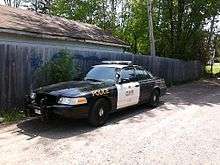
In 2007, the OPP announced that it would return to a black-and-white colour scheme for its police cruisers. Historically, the force had used black-and-white vehicles from the introduction of the first marked police cars in 1941 to 1989 when all-white cars with blue and gold striping were introduced. The change was implemented starting in March 2007 and was completed in 2009.
The OPP has approximately 1,200 patrol cars in service throughout the province. Common models include the Ford Crown Victoria Police Interceptor, Chevrolet Tahoe, Ford Fusion Hybrid, Ford Explorer and Dodge Charger. Various vans and SUVs are used as support vehicles including 52 prisoner transport vehicles that are specially designed to transport up to 24 prisoners at a time. Harley Davidson FL motorcycles are used for traffic patrol in the summer months. The implementation of the Snowmobile ATV and Vessel Enforcement (SAVE) units has brought ATVs into the forefront of proactive policing of recreational activities.
The OPP has two Cambli International Thunder 1 armoured rescue vehicles since 2012 for [19] shared by 3 Tactics and Rescue Units in the province.
Aviation
- Two Eurocopter EC135 helicopters received May 27, 2011 replacing Eurocopter AS350
- One Pilatus PC12NG
- One Cessna 206 Turbo
Marine
- LIMESTONE 350 Chevrolet Engine marine vessel
- Harbourcraft 17/19 ft. marine vessels
- LOWE Sea Nymph 25 hp Mercury Marine vessel
- Seaswirl 21–24 ft. marine vessels
- Boston Whaler 21 ft. Justice Series
- Hike Marine ljhuhuhrious lengths ranging from 19–32 ft. and based on Georgian Bay and the Great Lakes areas.
- Kanter Marine "Chris D. Lewis" 38 Foot Police boat designed by Gregory C Marshall Naval Architect Ltd Named after Retired OPP Commissioner Christopher D Lewis
UAV
- Draganflyer X6 UAV helicopter by Draganfly Innovations[20]
- FIU-301 UAS—UAV plane
Weapons
- SIG Sauer P229
- Remington 870
- ARWEN 37
- Taser X26
- CQB Close Quarter Battle combat rifle—variant of Colt Canada C8 rifle
OPP in pop culture
The Beatles folklore
The Beatles's 1967 album Sgt. Pepper's Lonely Hearts Club Band contains cover art with Paul McCartney wearing an OPP patch on his fictional uniform (more easily seen in the gatefold picture). The patch was given to John Lennon the day after their 1966 concert in Toronto by a summer student working in the garage of the OPP Headquarters (The group was being transferred to a police van for the trip to the airport).
In January 2016 the origins of the patch was confirmed as a gift from an OPP Corporal on September 28, 1964 at Malton Airport as the Beatles were on their way to Montreal.[21]
Habbo Hotel
On the online social networking website Habbo Hotel Canada, OPP officers and spokespersons visit the online application to talk to teens on board the web site's "Infobus". During the weekly sessions, users of the Habbo service are able to ask the officers and spokespersons questions, primarily regarding online safety. During the Infobus sessions, the OPP officer talks to the users within the bus about cyberbullying and online safety. The OPP officer holding the session users staff specific tools to ask questions to the whole bus so a more direct answer can be given. This is by using the quiz tool in which users must vote on a multiple choice question which appears in an in-game pop-up. The OPP officers' Habbo account is also given moderation powers to control the bus behavior. The OPP officer ingame account is given the CAA badge. (CAA relates to the badge code used when uploading into the badge directory for the Hotels. The "CA" section of the badge relates to the Hotel and the "A" relates to it being the tenth badge to have been uploaded with the "CA" prefix.) This allows users to recognize them whilst in the game and it is this badge that gives them the housekeeping powers needed to run the Quiz Tool.
Other instances
In the Canadian horror film Pontypool, the OPP is called into the eponymous town to control a zombie outbreak, ultimately resulting in a massacre. The response of the government to this outbreak draws many parallels to Canadian separatist movements. The film's lead character, Grant Mazzy, vocally denounces the OPP's actions on the radio.
Kim Mitchell regularly wore an OPP hat as part of his visual trademark in the 1980s and early 1990s.
In the 1992 Degrassi film, School's Out, OPP cars are shown at the scene of a car accident involving Derek "Wheels" Wheeler and Lucy Fernandez.
Controversy
Ontario Provincial Police Association
The OPPA was established in 1954 to represent sworn and civilian members of the OPP, as well as OPP retirees.[22]
In March 2015 the Royal Canadian Mounted Police announced they were investigating fraud committed by three top executives of the OPPA.[23]
Further reading
- Higley, Dahn (1984). O.P.P.: The history of the Ontario Provincial Police Force. Toronto: Queen's Printer. ISBN 0-7743-8964-8.
- Barnes, Michael (1991). Policing Ontario: The OPP Today. Erin: Boston Mills Press. ISBN 1-55046-015-3.
- Maksymchuk, Andrew F. (2008). From MUSKEG to MURDER: Memories of Policing Ontario's Northwest. Trafford Publishing. ISBN 978-1-4251-7089-9.
- Maksymchuk, Andrew F. (2014). "Champions of the Dead": OPP Crime-fighters Seeking Proof of the Truth. FriesenPress. ISBN 978-1-4602-4828-7.
See also
References
- ↑ "The OPP Museum - Historical Highlights of the Ontario Provincial Police". Ontario Provincial Police. Retrieved 2012-06-19.
- 1 2 3 4 5 Ontario Provincial Police. "2008 Provincial Business Plan" (PDF). Archived from the original (PDF) on August 6, 2009. Retrieved 2009-04-17.
- ↑ http://www.fin.gov.on.ca/en/budget/estimates/2012-13/volume1/MCSCS_779.html
- ↑ Ontario Police Services Act
- ↑ "Ontario Provincial Police Detachment List". Ontario Provincial Police. Retrieved 2014-01-19.
- 1 2 The Police Act, 1946, S.O. 1946, c. 72, s. 3 , later replaced by The Police Act, 1949, S.O. 1949, c. 72
- ↑ An Act for the better preservation of the Peace, and the prevention of Riots and violent Outrages at and near Public Works while in progress of Construction, S.C. 1845, c. 6, s. 14 , later replaced by The Public Works Peace Preservation Act, S.O. 1910, c. 12, s. 13
- ↑ An Act respecting Constables, S.O. 1877, c. 20
- ↑ under The Mines Act, 1906, S.O. 1906, c. 24, s. 190
- ↑ confirmed by The Constables Act, S.O. 1910, c. 39, s. 17
- ↑ The Provincial Police Force Act, 1921, S.O. 1921, c. 45
- ↑ The Ontario Temperance Act, S.O. 1916, c. 50
- ↑ Police Services Act, R.S.O. 1990, c. P.15, s. 52
- ↑ "Auxiliary Policing". OPP. Retrieved October 7, 2014.
- ↑ http://www.opp100.ca/English/media/documents/backgrounder_long_eng.pdf
- ↑ "Contact Us". Ontario Provincial Police. Retrieved 2013-10-12.
- ↑ http://www.protectionservices.ca/f41/legislative-security-service-special-constable-queens-park-4336/
- ↑ "Ontario Provincial Police". www.opp.ca. Retrieved 2016-05-24.
- ↑ http://www.thestar.com/news/ontario/2011/09/28/opps_new_ride_armoured_rescue_vehicles.html
- ↑ http://www.draganfly.com/news/2009/03/26/draganflyer-x6-unmanned-aerial-vehicle-opp-police-applications/
- ↑ http://www.thestar.com/entertainment/stage/2016/01/18/sgt-peppers-iconic-photos-reveal-opp-badge-on-paul-mccartneys-uniform.html
- ↑ https://www.oppa.ca/about/our-history
- ↑ http://www.ctvnews.ca/canada/unusual-transactions-in-opp-union-funds-among-allegations-against-top-execs-1.2278747
External links
| Wikimedia Commons has media related to Ontario Provincial Police. |
| Wikinews has related news: |
- Ontario Provincial Police Website
- Road Watch, was started by the Caledon, Ontario Provincial Police detachment.
- Highway Safety Division - Aircraft Enforcement Program
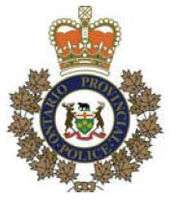


.svg.png)